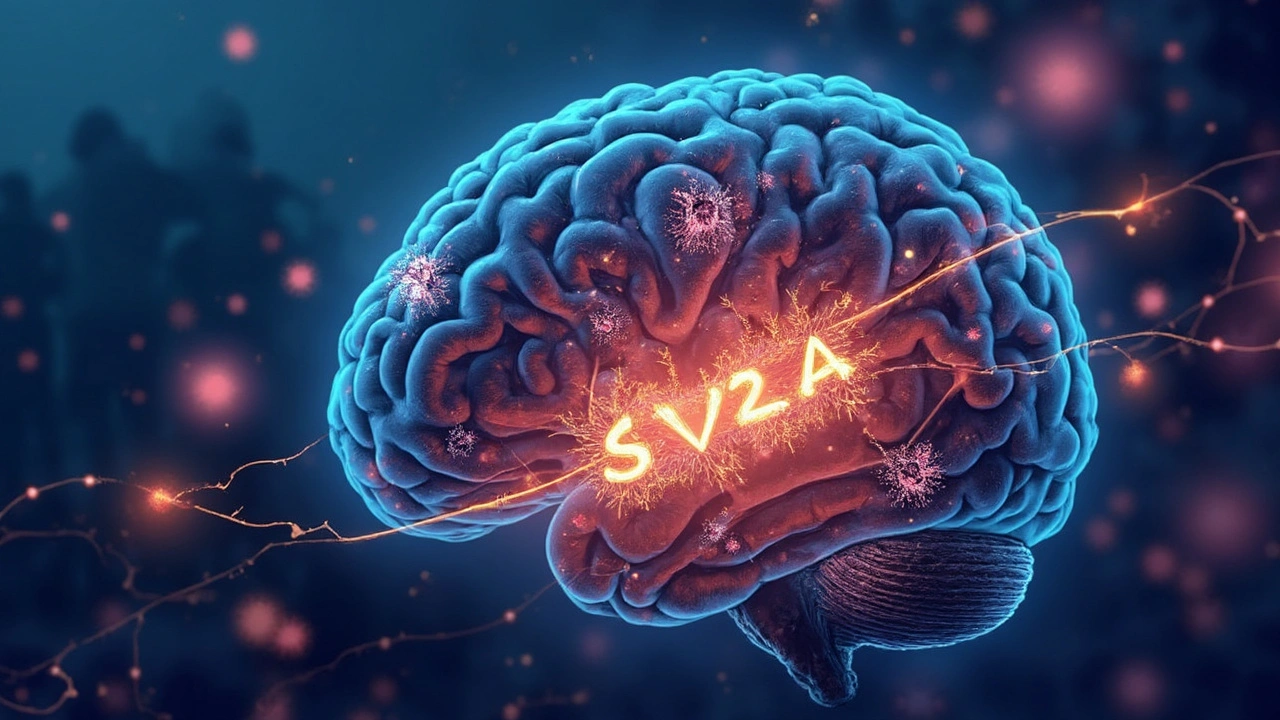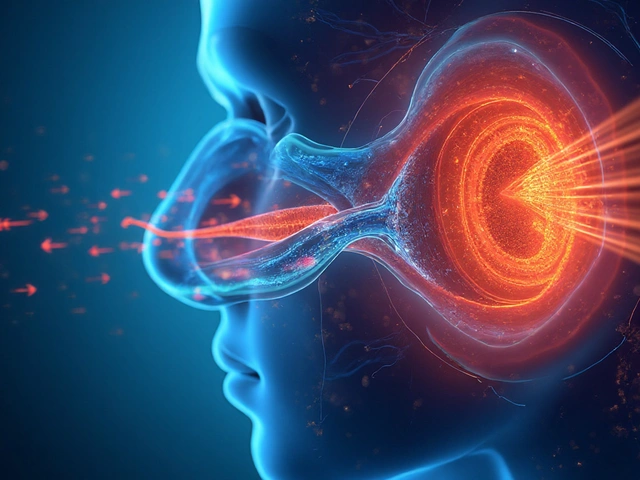SV2A: Unlocking New Hope for Psychiatric and Neurodegenerative Diseases
If you told a room full of neurologists ten years ago that a protein mostly famous for its role in epilepsy could be the next big thing in treating schizophrenia or even Alzheimer’s, you’d probably get a few raised eyebrows. Yet here we are in 2025, with SV2A—a tongue-twister that stands for Synaptic Vesicle Glycoprotein 2A—looking suspiciously like the Swiss Army knife of brain disorder targets. It’s the sort of twist that keeps researchers up at night (and probably gives hope to a lot of families desperately waiting for something, anything, to break through the wall of drug failures and side effects that marks psychiatric and neurodegenerative medicine these days.)
SV2A: Not Just About Seizures Anymore
So, what’s the deal with SV2A? Let’s picture the brain as a massive city with billions of people (neurons) trying to mail letters (neurotransmitters) back and forth all day. SV2A is a bit like the barcode and stamp system that makes sure messages get sent correctly. It sits on the tiny vesicles (bubble-like packaging) inside neurons and helps them load up and release the chemical signals that allow everything—thought, mood, memory, movement—to actually happen.
For years, SV2A was mainly a nerdy detail in textbooks about seizures because of one key molecule: levetiracetam. This anti-seizure drug binds to SV2A and has kept millions of people’s epilepsy in check worldwide. Here’s the twist. People on levetiracetam sometimes reported shifts in mood or thinking that couldn’t be chalked up to seizures alone. That got scientists poking around to ask, "Could SV2A be messing with other brain conditions, too?"
And the answer might be yes—big time. SV2A isn’t just found in one corner of the brain linked to seizures. It turns up everywhere from the frontal cortex (where decision-making lives) to the hippocampus (your memory storage unit) to the amygdala (the center of emotion and anxiety.) Around the world, labs are now using SV2A PET scans to map its presence in live brains. Turns out, people with schizophrenia, depression, and even autism show subtle but real changes in SV2A density compared to the rest of us.
Here’s a snapshot of what we know so far:
| Disease | SV2A Pattern | What it Might Mean |
|---|---|---|
| Epilepsy | Widespread SV2A loss in seizure-prone brain areas | Disrupted neurotransmitter release; seizures |
| Schizophrenia | Reduced SV2A in cortex and hippocampus | Possible synaptic dysfunction tied to thinking/mood |
| Alzheimer’s disease | Severe drop in SV2A as disease advances | Loss of functional brain connections, memory issues |
That’s heavy—but also hope-inducing. Instead of targeting symptoms, fixing SV2A could mean actually repairing some broken connections in the brain. And who wouldn’t want that, if your dad is losing his memory or your best friend can’t shake disabling depression?

The Psychiatric Frontier: SV2A in Depression, Schizophrenia & Beyond
Dig into recent journal articles and SV2A looks like the star guest you never expected at the psychiatry dinner party. Take depression, for instance. Several research groups have used new scanning techniques to find that adults with hard-to-treat depression show up to 25% less SV2A in key parts of the brain. This isn’t a small, "maybe it matters" finding—it hints at missing pieces in the machinery that shuffles mood-balancing chemicals like serotonin and dopamine.
Some scientists have begun testing old and new SV2A-targeting treatments to see if they might lift depression or even anxiety. While levetiracetam isn’t quite the miracle for mood as it is for seizures (some users even report mood swings or irritation), modified versions are on the horizon that tweak its brain action and reduce side effects.
In schizophrenia, the stakes are even higher. The usual suspects—dopamine blockers—help a bit but leave most people struggling. PET scan studies in young adults at high risk for psychosis have shown they already have less SV2A in certain brain areas before their first psychotic break. This suggests the protein plays a role in the earliest, most preventable stages of illness. In some studies, small doses of levetiracetam temporarily boosted brain network efficiency, hinting at a way to make "wiring" in the brain work better for patients who have run out of other options.
What about autism? Though the research is fresher, there’s evidence that SV2A mutations or signaling issues could link to the disrupted sensory processing and repetitive behaviors seen in autism spectrum disorders. That opens up conversations about testing SV2A-active drugs as future add-ons to help with social skills or sensory overload.
Of course, you can’t just hand out SV2A drugs like sweets. Not everyone’s brain chemistry is the same. The science here is young, but it’s overflowing with potential. Some researchers are building molecules that nudge SV2A up or down only in certain brain regions, aiming to avoid the negative mood reactions that sometimes crop up when you mess with the entire SV2A system at once. That’s key if any of these ideas are going to turn into real, useful medications.
One tip for families or patients: If you’re considering new treatments aimed at SV2A, ask if your doctor can access SV2A PET imaging studies, or if you’re eligible for clinical trials. The more info you have about your own SV2A signature, the smarter those medication choices will be. As a side note, a good explainer about the history and technical side of SV2A action in drugs like levetiracetam is available through this SV2A binding research resource, which unpacks the details without drowning you in jargon.
Real-world reminder: I’ve chatted with folks here in Birmingham—parents, carers, people living with schizophrenia—who sometimes describe new treatments as "shots in the dark," but they’re excited by this more targeted approach. "If they could figure out my son’s actual wiring instead of throwing pills at him based on guesswork, that’d be progress," one mum told me at a support group session. It’s early days, but the energy is real.

Can SV2A Revolutionize Treatment for Neurodegenerative Disease?
When it comes to conditions like Alzheimer’s disease, Parkinson’s, or even multiple sclerosis, researchers are used to disappointment. Drug after drug has failed to reverse, or even meaningfully slow, these devastating brain diseases. Recently, though, SV2A has popped up as a marker for synaptic loss—the literal dying of connections that makes these diseases so heartbreaking.
Here’s where things get interesting. Brain imaging studies in people with early Alzheimer’s have found SV2A levels drop before major memory loss sets in. That’s miles ahead of traditional scans, which only show blank spaces once damage is already done. Using SV2A PET scans, doctors can spot trouble brewing long before clinical symptoms take over, which could completely change how we diagnose and treat dementia.
More promising still, some experimental Alzheimer’s drugs are targeting SV2A directly. In early mouse studies, boosting SV2A seemed to rescue memory function and slow down brain cell death. And while you can’t run straight from mouse to human, the finding turns years of failed "amyloid" drugs on its head. Instead of cleaning up brain plaques after the damage, the focus shifts to maintaining healthy, active connections right from the start.
Parkinson’s is getting a share of the SV2A spotlight, too. The shaking, stiffness, and slow movement of Parkinson’s all trace back to dying dopamine neurons. But as those neurons break down, their SV2A drops off too. That means future drugs—and maybe even gene therapies—could target SV2A to keep these vital brain circuits firing for longer.
Let’s not forget everyday tips that spin off from this research. Staying mentally active, eating healthy, and keeping blood sugar in check all support brain connections, and by extension, may keep SV2A levels healthier for longer. Regular exercise can actually increase synaptic proteins in animal studies. If you’re worried about your own memory, simple things like puzzles, learning a new skill, or staying social can make a difference, especially if you start early.
Experts are optimistic but not naive. SV2A is not a magic bullet. It’s one part of a tangled web of proteins, chemicals, and genes that shape brain health. Sometimes SV2A loss is a signal—not just a cause—of deeper issues. Drug makers are approaching this with more humility than in the "blockbuster" drug days, looking for patient-tailored options and earlier diagnoses.
Do I think SV2A will be the story of the decade? Too soon to tell. But ask anyone who’s watched a loved one slip away from Alzheimer’s, or who’s been dismissed by doctors for "untreatable" depression, and they’ll tell you: any shot at new hope beats the alternative. For Oswald and Prudence, and all the families hoping today’s science delivers a better tomorrow, SV2A feels like a reason to keep paying attention.






16 Comments
Naomi Shimberg
May 21 2025SV2A is expressed ubiquitously across neuronal populations, yet therapeutic specificity remains uncertain. The protein's widespread presence does not inherently guarantee targeted efficacy, and history is replete with promising biomarkers that ultimately faltered in clinical translation. Moreover, reliance on PET imaging may introduce selection bias, privileging institutions equipped with such technology.
kenny lastimosa
May 31 2025The contemplation of SV2A invites us to reflect upon the intricate choreography of synaptic communication, wherein each vesicle contributes to the emergent tapestry of cognition. If we regard the brain as a symphony, perhaps augmenting a single instrument does not resolve dissonance caused by the full orchestra.
Heather ehlschide
June 9 2025For clinicians considering SV2A‑targeted trials, it is prudent to assess baseline PET data where feasible, and to stratify patients by disease stage to maximize signal detection. Additionally, monitoring for mood fluctuations remains essential, as levetiracetam‑derived compounds have exhibited subtle affective side‑effects.
Kajal Gupta
June 18 2025The emerging literature portrays SV2A as a versatile target that could address seizures, mood disturbances, and memory deficits alike. Yo, this whole SV2A hype feels like the brain’s own Swiss‑army knife-ready to slice through those issues without the usual side‑kick of drowsiness.
Zachary Blackwell
June 28 2025Even if you see it as a symphony, the real score is being written behind closed doors; pharmaceutical giants have long steered research toward “soft” targets that guarantee perpetual pipelines. SV2A’s rise may simply be the latest chapter in a curated narrative, designed to divert attention from truly disruptive modalities.
prithi mallick
July 7 2025i think the whole thing is cool but we cant ignore that many patiens already on levetiracetam report weird mood swings its like the drug is doing more than just calm seizures its messing with their brain chemistry
Michaela Dixon
July 16 2025It is fascinating how the discovery of SV2A’s broader involvement in neural circuitry has sparked a cascade of interdisciplinary collaborations that bridge molecular neurobiology, advanced imaging modalities, and clinical psychiatry as researchers worldwide scramble to map the protein’s distribution across pathological states the data emerging from PET studies illuminate subtle regional decrements in SV2A density that correlate with cognitive decline and negative symptomatology in schizophrenia while simultaneously revealing that early‑stage Alzheimer’s patients exhibit a precipitous drop in synaptic markers long before overt atrophy becomes apparent this temporal relationship suggests a window of opportunity for therapeutic intervention where augmenting SV2A function could theoretically stabilize synaptic integrity and perhaps slow neurodegeneration the challenge, however, lies in designing compounds that can selectively up‑regulate SV2A activity without triggering excitotoxic cascades or undesired alterations in neurotransmitter release a delicate balance must be achieved and preclinical models have begun to showcase promising results wherein SV2A agonists restored memory performance in rodent models of amyloid pathology yet the translational leap to human trials remains fraught with regulatory and safety considerations furthermore, the heterogeneity of psychiatric disorders implies that a one‑size‑fits‑all approach is unlikely to succeed and patient stratification based on SV2A PET imaging may become an indispensable tool in personalizing treatment regimens in the coming decade the ultimate success of this line of inquiry will hinge on collaborative efforts that integrate robust biomarker validation, longitudinal clinical assessments, and adaptive trial designs that can accommodate the nuanced responses observed across diverse patient populations
Dan Danuts
July 25 2025Wow, that deep dive really shows how far the field has come-let’s keep the momentum going and push for more open‑access data so everyone can ride this wave together!
Dante Russello
August 4 2025Indeed, the potential of SV2A as a therapeutic target is exciting; however, we must also recognize the limitations of current imaging resolution, the variability in patient populations, and the necessity for longitudinal studies, which together will inform whether modulation of this protein can yield durable clinical benefits.
James Gray
August 13 2025Guys, this could be a game changer, especially if we can get affordable PET scans into community hospitals – imagine the hope for families everywhere!
Scott Ring
August 22 2025From a cultural perspective, incorporating SV2A testing into routine care could also help reduce stigma by framing mental health issues as neurobiological conditions rather than moral failings.
Shubhi Sahni
August 31 2025Absolutely, Scott, by normalizing the conversation around brain biomarkers, we not only empower patients but also foster a more inclusive dialogue that bridges science and society, ultimately paving the way for compassionate, evidence‑based interventions.
Danielle St. Marie
September 10 2025Honestly, the hype is overblown 🤦♀️ most of these “breakthroughs” are just re‑packaged hype from big pharma, don’t be fooled 😒
keerthi yeligay
September 19 2025sv2a seems promising but need more data
Peter Richmond
September 28 2025Future research should prioritize randomized controlled trials to establish causality and safety profiles for SV2A‑modulating agents.
Bonnie Lin
October 7 2025Interesting developments.